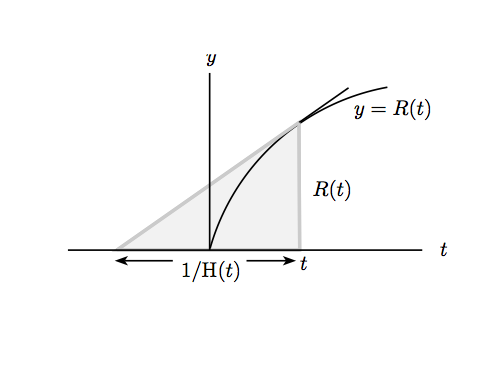Problem 20: Cosmological models ( ) 2001 Paper I
In a cosmological model, the radius of the universe is a function of the age of the universe. The function satisfies the three conditions:
| () |
where denotes the second derivative of . The function is defined by
- (i)
- Sketch a graph of . By considering a tangent to the graph, show that .
- (ii)
- Observations reveal that ,
where
is constant. Derive an expression for .
What range of values of is consistent with the three conditions ?
- (iii)
- Suppose, instead, that observations reveal that ,
where
is constant. Show that this is not consistent with conditions
for any value of .
Note: as for any constant .
Comments
The sketch just means any graph starting at the origin and increasing, but with decreasing gradient. The second part of (i) needs a bit of thought (where does the tangent intersect the -axis?) so don’t despair if you don’t see it immediately. Parts (ii) and (iii) are perhaps easier than part (i).
Solution to problem 20
(i) The figure shows the curve and the tangent to the curve, which meets the axis.
The height of the right-angled triangle in the figure is and the slope of the hypotenuse is . The length of the base is therefore , i.e. .
The figure shows that the tangent to the graph for intersects the negative –axis, so .

(ii) One way to proceed is to integrate the differential equation:
The first two conditions are satisfied if and . For the third condition, we have which is negative provided . The range of is therefore .
(iii) The obvious way to do this just follows part (ii). This time, we have
Thus . Clearly since for so provided . Furthermore (think about this!), so only the condition remains to be checked. Differentiating gives
This is positive when , which contradicts the condition .
Instead of solving the differential equation, we could proceed as follows. We have
This is positive when , which contradicts the condition .
Post-mortem
The interpretation of the conditions in of the question is as follows. The first condition says that the universe started from zero radius — in fact, from the ‘big bang’.
The second condition says that the universe is expanding. This was one of the key discoveries in cosmology in the last century. The quantity is called Hubble’s constant (though it varies with time). It measures the rate of expansion of the universe. Its reciprocal is the Hubble time. The present-day value of the Hubble time has been a matter of great debate but it seems to be about 14.4 billion years, greater than the age of the universe (as calculated using cosmological models of this sort) by about 0.5 billion years.
The last condition says that the expansion of the universe is slowing down. This is expected on physical grounds because of the gravitational attraction of galaxies on one another. However, current observations indicate that the expansion of the universe is speeding up, and this is thought to be due to the presence of dark energy.







